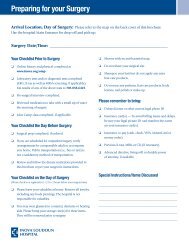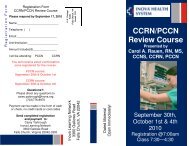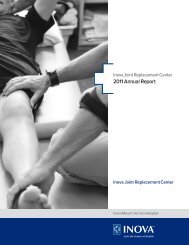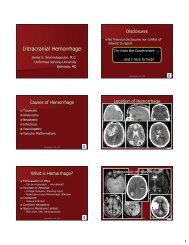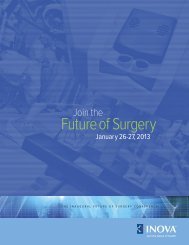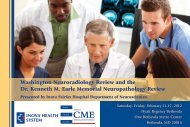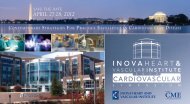Fairfax Hospital Neuroscience Services - Inova Health System
Fairfax Hospital Neuroscience Services - Inova Health System
Fairfax Hospital Neuroscience Services - Inova Health System
Create successful ePaper yourself
Turn your PDF publications into a flip-book with our unique Google optimized e-Paper software.
Hemorrhagic Stroke<br />
Subarachnoid hemorrhage (SAH) occurs when an aneurysm (a thin or weak spot in an<br />
artery that causes a bulge) ruptures and bleeds into the space between the brain and the skull<br />
(subarachnoid space). The most common causes of a SAH are:<br />
• Aneurysm – a weakened, ballooned area on an artery<br />
• Arteriovenous malformation (AVM) – a congenital disorder that consists of a<br />
disorderly tangled web of arteries and veins<br />
• Sometimes the cause is unknown<br />
How should an Aneurysm be treated?<br />
The best treatment depends on many things, including whether the aneurysm has ruptured or not.<br />
A ruptured aneurysm usually requires treatment right away, because the re-bleeding rate remains<br />
quite high. However, the treatment time and options for treatment depend upon the size, location<br />
and shape of the aneurysm, as well as your overall medical condition.<br />
If an aneurysm has not ruptured, the treatment decision still depends on size, location, and shape<br />
of the aneurysm. Each factor is important and requires consultation with a neurosurgeon and an<br />
interventional neuroradiologist who has special skills and training in treating these types of<br />
aneurysms. Before any treatment is considered, a diagnostic cerebral angiogram is usually<br />
performed in order to fully map out a plan for therapy.<br />
What treatments are available?<br />
• Medical therapy – Small, unruptured aneurysms that are not creating any symptoms<br />
may not need treatment unless they grow, trigger symptoms, or rupture. It is very<br />
important to have annual check-ups to monitor blood pressure, cholesterol, and other<br />
medical conditions. Smoking cessation is the most important thing you can do to reduce<br />
the risk from an aneurysm. Small, unruptured aneurysms require regular imaging<br />
examinations to make sure they have not grown or changed significantly.<br />
PATIENT INFORMATION GUIDE FOR STROKE<br />
inova.org/neuro





